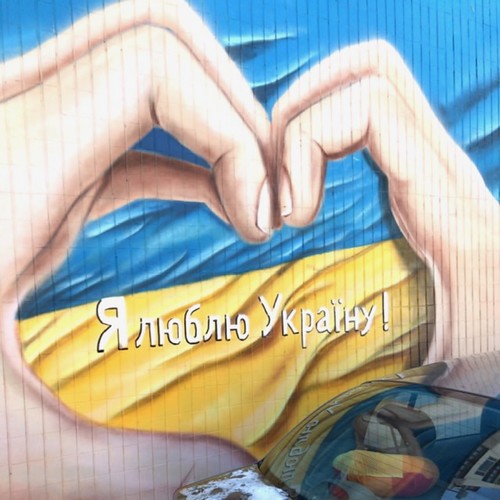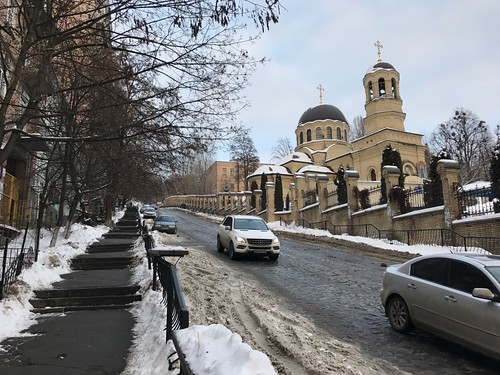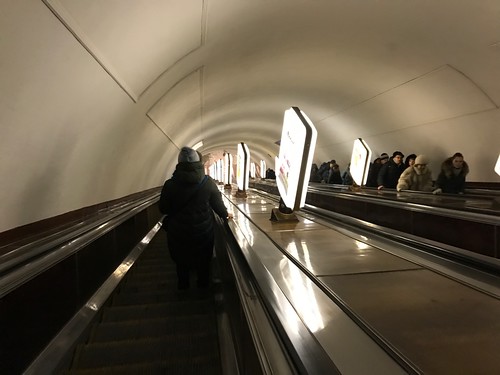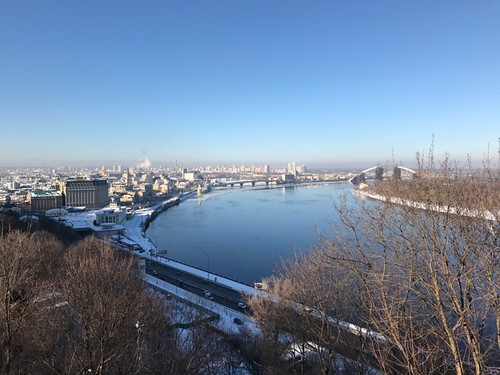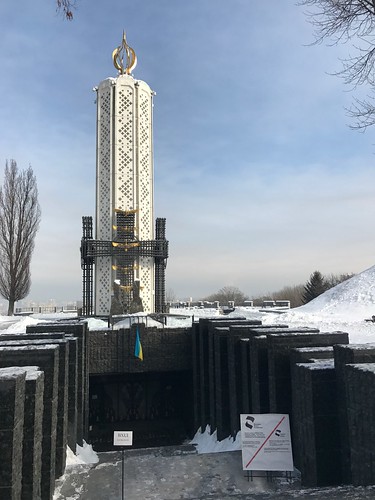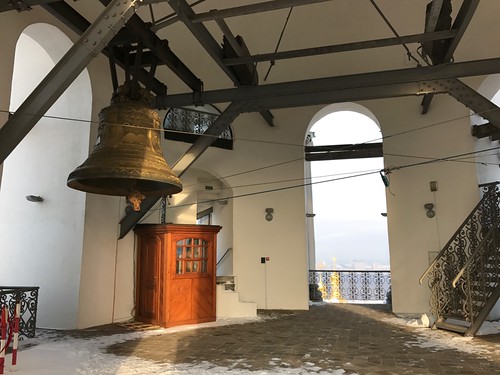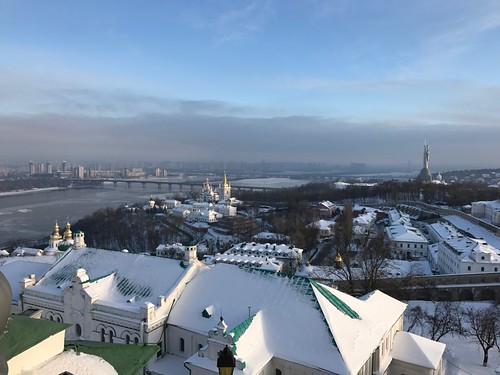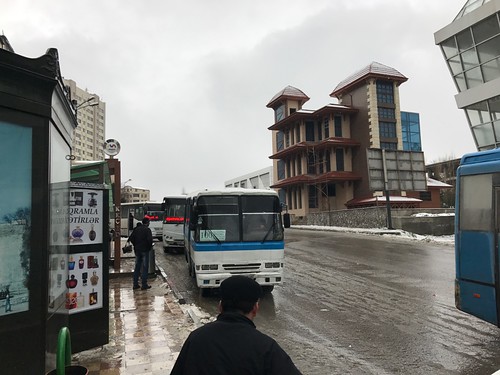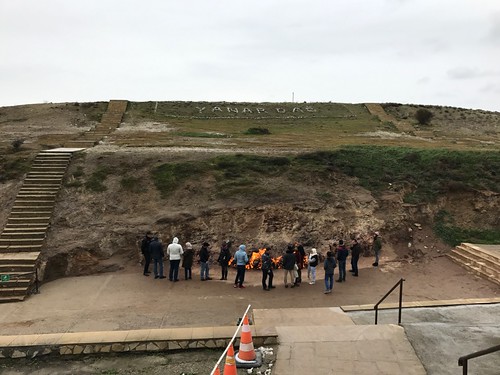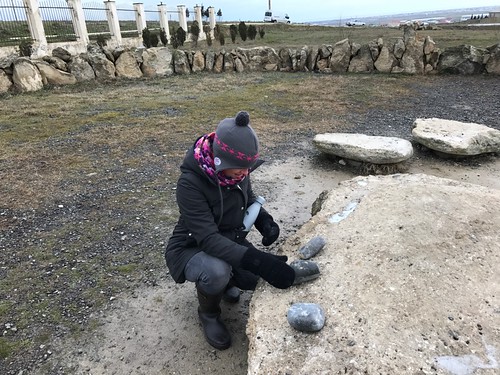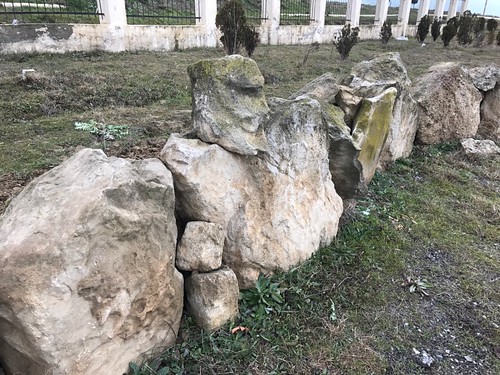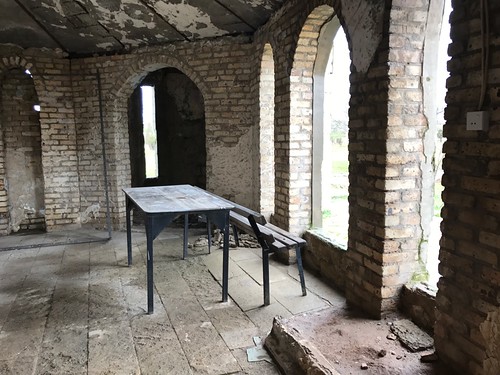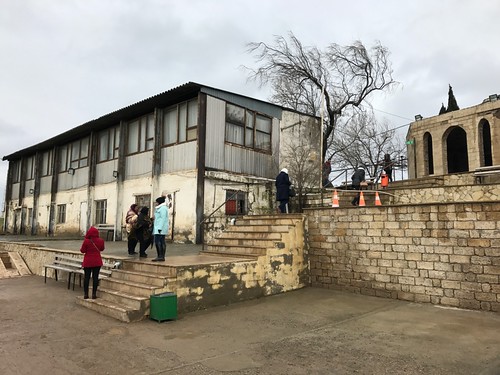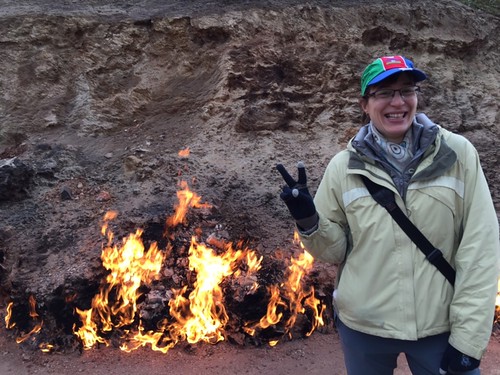I don't think Ukraine is the first place most people would decide to go when presented with a surfeit of vacation days and a dwindling window of time in which to take them. Especially not in February. But as Astute Go Stay Work Play Readers know by now, we here at GSWPL are not Most People. What we are is unwilling to spend half of a long weekend on planes and in airports trying to go somewhere too far away. We are also interested in going places we have not been before. And sometimes we can also be a bit cheap. (Oh, and we're still casually studying Russian, which is a lot like Ukrainian.) It turns out that when presented with those parameters Ukraine is the perfect destination, as long as one has a warm hat and long underwear. Kiev is a direct flight from Baku, and the flight times are very well-scheduled. And Airbnb places are ridiculously cheap. I got an entire 1 bedroom apartment to myself for the grand sum of £106 total for three nights. And the day-to-day costs of hanging out in Kiev are so low that I often second-guessed my calculations by a factor of ten when converting the currency in my head. (Example: the Uber I got from the apartment to dinner on the first night was £1.88. And a taster set of four different beers at dinner the second night was £0.78.)
So - Kiev! First of all it turns out that you're now supposed to spell it Kyiv. Kiev is the aglisized version of the Russian spelling, whereas Kyiv is the anglicised version of the Ukrainian spelling. In Ukraine it's now officially Kyiv, and even the Lonely Planet spells it that way so I suppose I should get with the times. I know this about the Lonely Planet, by the way, because the Intrepid Raul had already blazed the trail to Kyiv and loaned me his LP, which was my constant companion during the four days I had in the city.
This trip was less about being a tourist and more about having a break from work, even though work is busy enough that I almost bailed out completely. Instead, I took my computer and spent most mornings catching up on bits and pieces of work and hanging around the apartment. Then I headed out to be a tourist for the afternoon before going back home to put my feet up with a glass of wine and then finally venturing forth to stuff my face with stodge and pork products. This turned out to be an inspired and humane approach and one I might just to in all future trips, though hopefully with less working-in-the-morning and more louning-in-the-morning. Freeing oneself from the touristy need to fill every minute of the day is liberating.
But what about Kyiv itself? It felt comfy. Perhaps it's my increasing familiarity with former Soviet states, but I felt like I recognised it. It's got its share of Stalinist architecture and wide Soviet style streets. And there's Cyrillic everywhere, and the stick-to-your ribs food and the hopeful sense of a young country that's shaking off its subjugated past. And as a Canadian prairie kid, I grew up with friends and neighbours called Misanchuk and Shevchuk and Boyko, ate my share of perogies and cabbage rolls and sat though more than enough Ukrainian dance performances. About 1.2 million people in Canada identify as at least partly Ukrainian, giving Canada the third largest population of Ukrainians in the world (after Ukraine itself and Russia). So like I said, I was in familiar territory.
I had the best part of four days in Kyiv, which was plenty of time to hit the high points. And it turns out that Kyiv has, literally, got a lot of high points. Something I noticed right away is that its very hilly. The Dneiper river dominates the city, part of which sits on a high hilly ridge along the river, and part - the older bit - lower down along the river itself.
I spent my first afternoon doing the Lonely Planet walking tour of the city, which was a chilly but pleasant introduction. I started at the Arsenalna Metro station, which has the distinction of being the deepest metro station IN THE WORLD. And while the station itself was nothing special, it was two very very long escalator rides down. And for the bargain price of 8 hryvini, I got two metro tokens. (Hryvina is the currency in Ukraine. About 300 hryvni equal one pound sterling. So 8 hryvni is roughly 24 pence.)
The metro dropped me on the main drag, Kreshchatyk, where I tried unsuccessfully to find the famous Independence Square (you probably know this as "The Maidan"). Undaunted, I followed the tour as best I could, consulting the LP and Google Maps with freezing fingers and wandering in the bright cold through Marinsky Park and along the Dneiper, which truly is quite impressive.
Eventually, I grew too tired and cold to continue, and wisely found a warm café where I had a bowl of borscht. Then I made a quick pit stop for groceries, including a very nice chunk of unsliced side bacon and some kolbassa. What can I say? I live in an Islamic country these days - good bacon is a real treat. I also picked up a very nice bit of tvorog, which is a very Eastern European type of fresh cheese. It’s made in the same way as cottage cheese or quark, and is ubiquitous in these parts - it comes in a myriad of varieties in the supermarket. The bit I got at the market in downtown Kyiv was baked into what ended up very much like dense and slightly grainy cheesecake. It was really yummy for breakfast, along with the bacon, of course. (You may now be sensing this was not a particularly low-cal vacation. As it should be.)
After my bacon and cheesecake breakfast and a suitable loll about in the apartment on Friday I set out to visit the Kievo-Pecherska Lavra, one of Kyiv's not-to-be missed sites. "Lavra" is the word for a senior monastery, and Pecherska means "of the caves", so it's a monastery of caves. Sitting up on the high banks of the Dneiper, it's been the site of a monastic settlement since the 11th century, when a reclusive group of monks set themselves up in some existing caves and gradually enlarged them over time. The monastery grew, including more caves and buildings above ground as well, until the site now covers about 28 hectares. It was a 30 minutes walk from the apartment, though on the way I stumbled across another spot that really deserves mentioning.
I’m ashamed to say I’d never heard of this event before. Holodomor is a Ukrainian word that roughly translates as “death by hunger” or more specifically “murder by starvation” and refers to a man-made famine in 1932-33 caused by Soviet policies under Stalin that killed somewhere between 2 and 7 million Ukrainians. The events in Ukraine were part of a larger famine in the wider Soviet Union that happened partly as a result of poor grain harvests, but in Ukraine was hugely exacerbated by government policies such as the collectivisation of farms, the ever-increasing quotas required from them, and the brutal punishments exacted when enforcing those quotas. There are reports that taking even a few grains of wheat from the fields for oneself could result in arrest and execution. At its height starvation was killing 13,000 Ukrainians every day.
It seems astonishing that I can not have known about this, but until the fall of the Soviet Union little was known about the event in the West. The Soviet government vehemently denied the scale and causes of the famine, and it only began to become widely recognised in the 1980s. Interestingly, the first Holodomor memorial in the world was erected in Edmonton, Alberta in 1983. And Saskatchewan was the first jurisdiction in North America to recognise the Holodomor as genocide (a topic that is still widely debated). In Ukraine, public denial of the Holodomor was declared illegal in 2006.
The museum under the memorial is small and mostly in Ukrainian so I didn’t spend a lot of time there. But as I was leaving the women at the front desk asked me to stop and sign the visitor book, and then when they found out I was from Canada they gestured me into a side room where they played a short video in English. As I was watching, I couldn’t help but think the accent of the narrator sounded familiar, and at the end I was surprised and proud to see that the film had been produced by the Canadian Museum for Human Rights in Winnipeg. Oh, and there’s a memorial statue near the Kyiv Holodomor museum called “Bitter Memory of Childhood”, a copy of which stands on the grounds of the provincial legislature in Winnipeg. It was all very full-circle-y.
After that poignant detour, I continued on my way to the aforementioned monastery. There are six churches and numerous other buildings at the site, but really everyone comes for the caves. And it's not even really the caves that they come for. They come for the ancient mummified monks IN the caves. Of course. Over the centuries when monks of the monastery died their bodies were kept in the caves, where the unique combination of cool temperatures and dry atmosphere caused the bodies to be naturally mummified. They’re now revered as saints and holy relics and the caves are open to worshippers at no charge. If a heathen like me wants to see the whole complex they need to buy a guided tour for 250 UAH (about £7.50). This got me a personal guide who who showed me through the entire Near Caves complex. (There’s also another set of caves down the hill called, unsurprisingly, the Far Caves.)
Entrance was through a church where I picked up a loaner wraparound skirt, because even if your female limbs are all covered with long trousers it’s still not modest enough for entry. I also got a long skinny candle to carry for light, because though I could see the caves have been wired for electricity, the lights weren’t on and the whole place was lit with candles. "Caves" makes one expect damp drippiness and (hopefully) some good stalagmites, but this was not like that at all. I suppose it’s been centuries since they were so primitive. Now the walls are smooth and white and the whole thing was pleasantly warm and dry. (For Astute Saskatoon-Savvy GSWPL readers: It reminded me of nothing so much as The Cave restaurant on 8th street, but with less lasagna and more mummies.)
The smooth white corridors are lined with niches and small rooms off to the sides, all of which house tiny glass-windowed coffins holding the earthly remains of the monastery’s most devout and revered inhabitants. They’re all covered in ornate gold-embroidered cloths, though in one or two places you can see and shrivelled toe or hand poking out. As we walked through the low corridors, my guide mumbled a seemingly endless and slightly monotonous litany about each saint we passed. “Here is the holy relic of St. Nestor, the chronicler…” and so on. It was interesting, but also weird. It was also fairly busy, and most of the people there were clearly worshippers - they’d stop at each coffin and cross themselves, often bending to kiss the coffin. It felt really intrusive to be there, but it was also fascinating.
I think the whole tour took about half an hour, and by the end I was very ready for a bit of fresh air and some lunch. Luckily, there was a small cafeteria on site that was obviously there to serve not just the tourists but also the staff and the monks who live at the site - it’s still an active working monastery. The cafeteria was warm and cheap and was serving hot food and strong tea. I got a really nice plate of pelmeni with smetana and a cup of sweet black tea and a very tasty cake of tvorog for the grand sum of £1.12.
Thus fortified, I wandered out to see what else there was to see in the Lavra complex, and ended up finding the Great Bell Tower. This turned out to be the utterly excellent. The bell tower was constructed in the mid-eighteenth century and was recently renovated. I wasn’t sure what to expect, but figured I’d at least get a nice view and the chance for a few photos take with frozen fingers. When I got to the top of the slightly treacherous frost-covered stairs I was so delighted I laughed out loud. The top opens out to amazing views across Kyiv in all directions, and since the renovation, all the bells have been re-hung with the ropes that control them strung across the room. And I had the whole place to myself.
I lingered for as long as I could stand, with my fingers getting more and more numb and my nose getter more and more sniffly. Then another group of tourists arrived, which I took as my cue to leave. I picked my way down the slippery stairs feeling very very satisfied with the day’s efforts. Bacon, Holodomor, caves, mummies, pelmeni, bells… and there was still more to come.
However, this blog is already a bit long, so I think I’ll pick up Part 2 later. Rest assured there will be more sites and more bacon and, finally, perogies and Chicken Kiev!
So - Kiev! First of all it turns out that you're now supposed to spell it Kyiv. Kiev is the aglisized version of the Russian spelling, whereas Kyiv is the anglicised version of the Ukrainian spelling. In Ukraine it's now officially Kyiv, and even the Lonely Planet spells it that way so I suppose I should get with the times. I know this about the Lonely Planet, by the way, because the Intrepid Raul had already blazed the trail to Kyiv and loaned me his LP, which was my constant companion during the four days I had in the city.
Я также люблю Украину!
But what about Kyiv itself? It felt comfy. Perhaps it's my increasing familiarity with former Soviet states, but I felt like I recognised it. It's got its share of Stalinist architecture and wide Soviet style streets. And there's Cyrillic everywhere, and the stick-to-your ribs food and the hopeful sense of a young country that's shaking off its subjugated past. And as a Canadian prairie kid, I grew up with friends and neighbours called Misanchuk and Shevchuk and Boyko, ate my share of perogies and cabbage rolls and sat though more than enough Ukrainian dance performances. About 1.2 million people in Canada identify as at least partly Ukrainian, giving Canada the third largest population of Ukrainians in the world (after Ukraine itself and Russia). So like I said, I was in familiar territory.
I had the best part of four days in Kyiv, which was plenty of time to hit the high points. And it turns out that Kyiv has, literally, got a lot of high points. Something I noticed right away is that its very hilly. The Dneiper river dominates the city, part of which sits on a high hilly ridge along the river, and part - the older bit - lower down along the river itself.
Here’s the climb from the downtown area towards my apartment.
The outside of the metro station
This is just one of the escalators. The station is 105 metres deep!
View over the river
After my bacon and cheesecake breakfast and a suitable loll about in the apartment on Friday I set out to visit the Kievo-Pecherska Lavra, one of Kyiv's not-to-be missed sites. "Lavra" is the word for a senior monastery, and Pecherska means "of the caves", so it's a monastery of caves. Sitting up on the high banks of the Dneiper, it's been the site of a monastic settlement since the 11th century, when a reclusive group of monks set themselves up in some existing caves and gradually enlarged them over time. The monastery grew, including more caves and buildings above ground as well, until the site now covers about 28 hectares. It was a 30 minutes walk from the apartment, though on the way I stumbled across another spot that really deserves mentioning.
This is the monument to the Holodomor. (Pronounced Huh-luh-duh-MORE)
It seems astonishing that I can not have known about this, but until the fall of the Soviet Union little was known about the event in the West. The Soviet government vehemently denied the scale and causes of the famine, and it only began to become widely recognised in the 1980s. Interestingly, the first Holodomor memorial in the world was erected in Edmonton, Alberta in 1983. And Saskatchewan was the first jurisdiction in North America to recognise the Holodomor as genocide (a topic that is still widely debated). In Ukraine, public denial of the Holodomor was declared illegal in 2006.
The museum under the memorial is small and mostly in Ukrainian so I didn’t spend a lot of time there. But as I was leaving the women at the front desk asked me to stop and sign the visitor book, and then when they found out I was from Canada they gestured me into a side room where they played a short video in English. As I was watching, I couldn’t help but think the accent of the narrator sounded familiar, and at the end I was surprised and proud to see that the film had been produced by the Canadian Museum for Human Rights in Winnipeg. Oh, and there’s a memorial statue near the Kyiv Holodomor museum called “Bitter Memory of Childhood”, a copy of which stands on the grounds of the provincial legislature in Winnipeg. It was all very full-circle-y.
After that poignant detour, I continued on my way to the aforementioned monastery. There are six churches and numerous other buildings at the site, but really everyone comes for the caves. And it's not even really the caves that they come for. They come for the ancient mummified monks IN the caves. Of course. Over the centuries when monks of the monastery died their bodies were kept in the caves, where the unique combination of cool temperatures and dry atmosphere caused the bodies to be naturally mummified. They’re now revered as saints and holy relics and the caves are open to worshippers at no charge. If a heathen like me wants to see the whole complex they need to buy a guided tour for 250 UAH (about £7.50). This got me a personal guide who who showed me through the entire Near Caves complex. (There’s also another set of caves down the hill called, unsurprisingly, the Far Caves.)
Entrance was through a church where I picked up a loaner wraparound skirt, because even if your female limbs are all covered with long trousers it’s still not modest enough for entry. I also got a long skinny candle to carry for light, because though I could see the caves have been wired for electricity, the lights weren’t on and the whole place was lit with candles. "Caves" makes one expect damp drippiness and (hopefully) some good stalagmites, but this was not like that at all. I suppose it’s been centuries since they were so primitive. Now the walls are smooth and white and the whole thing was pleasantly warm and dry. (For Astute Saskatoon-Savvy GSWPL readers: It reminded me of nothing so much as The Cave restaurant on 8th street, but with less lasagna and more mummies.)
I didn't take any photos, so these are provided by Google.
There are tiny churches in some of the side rooms
It was really really really good. Plus the cake was shaped like an igloo. Or possibly a turtle.
Or probably some kind of igloo-turtle hybrid.
It was fantastic. Yes, it was drafty and freezing, but there were big beams and ropes and pulleys and giant bells and so how could you NOT love it?
And the view was not bad either
However, this blog is already a bit long, so I think I’ll pick up Part 2 later. Rest assured there will be more sites and more bacon and, finally, perogies and Chicken Kiev!

